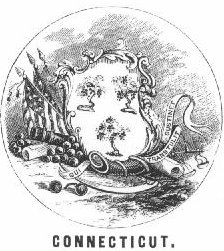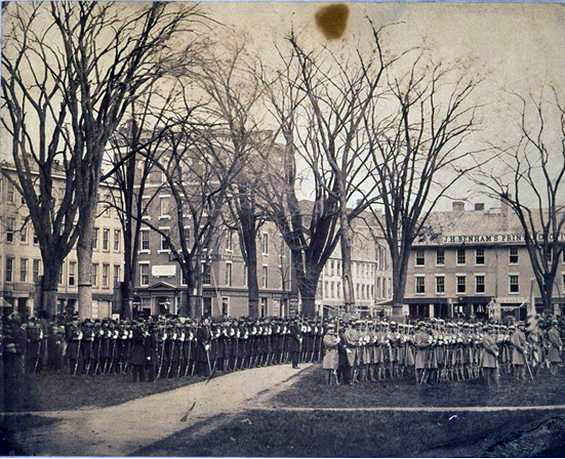History of the Third (Three Months) Connecticut Volunteers
 |
The volunteer companies which made up the Third three months regiment from Connecticut began their organization almost simultaneously with those which made up the First and Second. The original call of President Lincoln, however, only demanded one regiment from Connecticut, but the eagerness of Connecticut men to enlist induced Governor Buckingham to personally intercede with the President for the acceptance of at least three regiments, and this request being granted, the Third Regiment was very soon filled to the maximum. It went into camp at the Fair Grounds on Albany Avenue, in Hartford, on May 9th, and on May 14th was mustered into the United States service, with John Arnold of New Haven, Colonel, Allen G. Brady of Torrington, Lieut.-Colonel, and Alexander Warner of Woodstock, Major. |
|
The regiment left Hartford by rail for New Haven, May 23d, receiving its colors from the hands of Governor Buckingham, in front of the State House, in Hartford, when in line for departure, and sailed from New Haven for Washington on the steamer "Cahawba," via Chesapeake Bay and the Potomac. | |
|
Arriving at Washington, it immediately went into camp at Glenwood, near the First and Second regiments, and was at once brigaded with them under Brigadier-General Dan. Tyler, who had been promoted from the Colonelcy of the First Regiment to the command of the brigade. Colonel John Arnold soon resigned, and Lieut.-Colonel Chatfield of the First Regiment was commissioned by Governor Buckingham as Colonel of the Third Regiment, and, being promptly mustered as such, assumed command. |
|
|
Colonel Chatfield had the advantage of long experience as a militia officer, was an excellent drill-master and disciplinarian, and knew not how to tolerate insubordination in any form. Lieut.-Colonel Brady considered that the commissioning of Colonel Chatfield over himself in the Third Regiment was a violation by the Governor of the current regulations and usages of the State militia, and refused to recognize Colonel Chatfield as his superior. For this insubordination, Lieut.-Colonel Brady was deprived of his sword during the remainder of the three months' term of service, but was honorably mustered out at its close. Lieut.-Colonel Brady's impetuous indiscretion in this instance was most amply atoned for by his subsequent honorable and extremely efficient service in the Seven-teenth Connecticut Volunteers, and in the Veteran Reserve Corps. On June 24th, the Third Regiment followed the First and Second across Long Bridge to the "sacred soil" of Virginia, and encamped beside them at Falls Church, which was then the extreme and much exposed outpost of the Union lines. The Third here became a part of the First Brigade, First Division, of McDowell's "Army of the Potomac," and was destined as such to march at the head of the column in the soon-coming and clamorously-demanded “On to Richmond." The energy and military ability of Colonel Chatfield brought the Third to a remarkable degree of efficiency, as was soon demonstrated in the field. The Third moved with its brigade at the head of the column under McDowell when it advanced via Centreville to Bull Run, and, in the trying scenes on that disastrous field, behaved with the firmness and the courage of a regiment of veterans. Prior to this advance, General Dan. Tyler had been promoted to the command of the First Division of McDowell's army. Colonel Keyes, a West Point graduate and regular army officer, afterwards a major-general of volunteers, took command of the brigade. In his official report of the Bull Run battle, Colonel Keyes says: "At about two o'clock P. M., General Tyler ordered me to take a battery on a height in front. The battery was strongly posted and supported by infantry and riflemen, sheltered by a building, a fence, and a hedge. My order to charge was obeyed with the utmost promptness. Colonel Jameson of the Second Maine, and Colonel Chatfield of the Third Connecticut Volunteers, pressed forward their regiments up the base of the slope about one hundred yards, when I ordered them to lie down, at a point offering a small protection, and load. I then ordered them to advance again, which they did, in the face of a movable battery of eight pieces and a large body of infantry, toward the top of the hill. As we moved forward, we came under the fire of other large bodies of the enemy, posted behind breastworks, and on reaching the top of the hill the firing became so hot that an exposure to it of five minutes would have annihilated my whole line.” Farther on in his report, Colonel Keyes says: "The gallantry with which the Second Regiment of Maine, and the Third Regiment of Connecticut Volunteers, charged up the hill upon the enemy's artillery and infantry was never, in my judgment, surpassed." | |
|
| |
|
In obedience to orders, the Third, with the rest of the brigade, was soon after this action in retreat upon Centreville, but in good order. It bivouacked that night on the very ground it left on the morning of the battle, but about 10 P. M., after the demoralized portion of McDowell's army was far on its way toward Washington, orders were given to continue the march to Falls Church. From that point, and during the two following days, the Third, with the other Connecticut regiments, was busily engaged, without the semblance of panic, in saving camp and garrison equipage and stores abandoned by the other troops. | |
|
The Third was mustered out of service at Hartford, August 12, 1861 | |
Casualties Third
Field and Staff A B C D E F G H I K Total Killed 1 1 1 1 4 MIA 1 1 Wounded 3 1 1 3 1 1 10 Captured 1 1 1 1 5 1 1 2 4 17 Discharged/ Disability 3 1 1 2 2 1 2 2 14 Total 1 5 4 1 4 3 9 2 6 6 5 46
Editor’s Note: This is the third monthly installment of the history of



